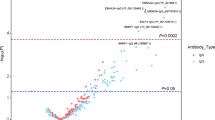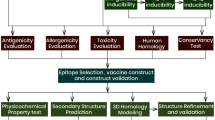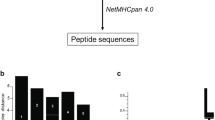Abstract
THE Epstein–Barr virus (EBV)-encoded nuclear antigen (EBNA1) is expressed in latently EBV-infected B lymphocytes that persist for life in healthy virus carriers1,2, and is the only viral protein regularly detected in all malignancies associated with EBV3,4. Major histocompatibility complex (MHC) class I-restricted, EBNA1-specific cytotoxic T lymphocyte (CTL) responses have not been demonstrated3,5. Using recombinant vaccinia viruses encoding chimaeric proteins containing an immunodominant human leukocyte antigen All-restricted CTL epitope, amino acids 416–424 of the EBNA4 protein6, inserted within the intact EBNA1, or within an EBNA1 deletion mutant devoid of the internal Gly–Ala repetitive sequence, we demonstrate that the Gly–Ala repeats generate a cis-acting inhibitory signal that interferes with antigen processing and MHC class I-restricted presentation. Insertion of the Gly–Ala repeats downstream of the 416–424 epitope inhibited CTL recognition of a chimaeric EBNA4 protein. The results highlight a previously unknown mechanism of viral escape from CTL surveillance, and support the view that the resistance of cells expressing EBNA1 to rejection mediated by CTL is a critical requirement for EBV persistence and pathogenesis.
This is a preview of subscription content, access via your institution
Access options
Subscribe to this journal
Receive 51 print issues and online access
$199.00 per year
only $3.90 per issue
Buy this article
- Purchase on SpringerLink
- Instant access to full article PDF
Prices may be subject to local taxes which are calculated during checkout
Similar content being viewed by others

References
Tierney, R. J., Steven, N., Young, L. S. & Rickinson, A. B. J. Virol. 68, 7374–7385 (1994).
Chen, F. et al. J. Virol (in the press).
Masucci, M. G. & Ernberg, I. Trends Microbiol. 2, 125–130 (1994).
Klein, G. Cell 77, 791–793 (1994).
Rickinson, A. et al. in A New Look at Tumor Immunology (eds McMichael, A. & Franks, L.) 53–80 (Cold Spring Harbor Laboratory Press, New York, 1992).
Gavioli, R. et al. J. Virol. 67, 1572–1578 (1993).
Rawlins, D. R., Milman, G., Hayward, D. S. & Haywards, G. S. Cell 42, 859–868 (1985).
Baer, R. et al. Nature 310, 207–211 (1984).
Dillner, J. et al. Proc. natn. Acad. Sci. U.S.A. 81, 4652–4656 (1984).
de Campos-Lima, P. O. et al. J. exp. Med. 179, 1297–1305 (1994).
Steigewald-Mullen, P. M. & Kurilla, M. G. J. gen. Virol. (in the press).
Bangham, C. R. M. et al. J. Immun. 137, 3973–3977 (1986).
Lee, P. & Hruby, D. E. J. Virol. 67, 4252–4263 (1993).
Murray, R. et al. J. exp. Med. 176, 157–168 (1992).
Michalek, M. T., Grant, E. P., Gramm, C., Goldberg, A. L. & Rock, K. L. Nature 363, 552–554 (1993).
Rock, K. L. et al. Cell 78, 761–771 (1994).
Ciechanover, A. Cell 79, 13–21 (1994).
Tsubota, H., Lord, C. I., Watkins, D. I., Morimoto, C. & Letvin, N. L. J. exp. Med. 169, 1421–1434 (1989).
Lukacher, A. E., Braciale, V. L. & Braciale, T. J. J. exp. Med. 160, 814–826 (1984).
Byrne, J. A. & Oldstone, M. B. A. J. Virol. 51, 682–686 (1984).
Burgert, H. G., Maryansky, J. L. & Kvist, S. Proc. natn. Acad. Sci. U.S.A. 84, 1356–1359 (1987).
Phillips, R. et al. Nature 354, 453–459 (1991).
Pircher, H. et al. Nature 346, 629–633 (1990).
Klenerman, P. et al. Nature 369, 403–407 (1994).
Bertoletti, A. et al. Nature 369, 407–410 (1994).
Tishon, A., Borrow, P., Evans, C. & A., O. M. B. Virology 195, 397–405 (1993).
Moskophidis, D., Lechner, F., Pircher, H. & Zinkernagel, R. M. Nature 362, 758–761 (1993).
Reedman, B. M. & Klein, G. Int. J. Cancer 11, 499–520 (1973).
Chen, M.-R., Middletorp, J. M. & Hayward, D. J. Virol. 67, 4875–4885 (1993).
Author information
Authors and Affiliations
Rights and permissions
About this article
Cite this article
Levitskaya, J., Coram, M., Levitsky, V. et al. Inhibition of antigen processing by the internal repeat region of the Epstein–Barr virus nuclear antigen-1. Nature 375, 685–688 (1995). https://doi.org/10.1038/375685a0
Received:
Accepted:
Issue Date:
DOI: https://doi.org/10.1038/375685a0
This article is cited by
-
Exploring the link between viruses and cancer in companion animals: a comprehensive and comparative analysis
Infectious Agents and Cancer (2023)
-
The lytic phase of Epstein–Barr virus plays an important role in tumorigenesis
Virus Genes (2023)
-
SARS-CoV-2 inhibits induction of the MHC class I pathway by targeting the STAT1-IRF1-NLRC5 axis
Nature Communications (2021)
-
The molecular march of primary and recurrent nasopharyngeal carcinoma
Oncogene (2021)
-
Virus-Specific T Cells for the Treatment of Malignancies—Then, Now, and the Future
Current Stem Cell Reports (2020)


